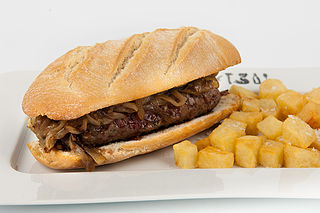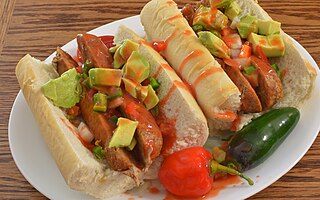
New England cuisine is an American cuisine which originated in the New England region of the United States, and traces its roots to English cuisine. It is characterized by extensive use of seafood and dairy products, resulting from its historical reliance on its seaports and fishing industry, as well as extensive dairy farming in inland regions.

A submarine sandwich, also known as a sub, hoagie, torpedo, hero, or grinder, is a type of cold sandwich made from a cylindrical bread roll split lengthwise and filled with meats, cheeses, vegetables, and condiments. It has many different names.

Turkish cuisine is largely the heritage of Ottoman cuisine, which can be described as a fusion and refinement of Mediterranean, Balkan, Middle Eastern, Central Asian, Eastern European and Armenian cuisines. Turkish cuisine has in turn influenced those and other neighbouring cuisines, including those of Southeast Europe (Balkans), Central Europe, and Western Europe. The Ottomans fused various culinary traditions of their realm with influences from Levantine cuisines, Egyptian cuisine, Greek cuisine, Balkan cuisine, along with traditional Turkic elements from Central Asia, creating a vast array of specialities.

A cheesesteak is a sandwich made from thinly sliced pieces of beefsteak and melted cheese in a long hoagie roll. A popular regional fast food, it has its roots in the U.S. city of Philadelphia, Pennsylvania.

A Dagwood sandwich is a tall, multilayered sandwich made with a variety of meats, cheeses, and condiments. It is named after Dagwood Bumstead, a central character in the comic strip Blondie, who is frequently illustrated making enormous sandwiches. According to Blondie scripter Dean Young, his father, Chic Young, began drawing the huge sandwiches in the comic strip during 1936.

Coleslaw, also known as cole slaw, "New England Salad", or simply slaw, is a side dish consisting primarily of finely shredded raw cabbage with a salad dressing, commonly either vinaigrette or mayonnaise. Coleslaw prepared with vinaigrette may benefit from the long lifespan granted by pickling.

Iraqi cuisine or Mesopotamian cuisine has its origins from Sumerians, Akkadians, Babylonians, Assyrians, ancient Persians, Mesopotamian Arabs, and the other ethnic groups of the region.

Czech cuisine has both influenced and been influenced by the cuisines of surrounding countries and nations. Many of the cakes and pastries that are popular in Central Europe originated within the Czech lands. Contemporary Czech cuisine is more meat-based than in previous periods; the current abundance of farmable meat has enriched its presence in regional cuisine. Traditionally, meat has been reserved for once-weekly consumption, typically on weekends. The body of Czech meals typically consists of two or more courses; the first course is traditionally soup, the second course is the main dish, and the third course can include supplementary courses, such as dessert or compote. In the Czech cuisine, thick soups and many kinds of sauces, both based on stewed or cooked vegetables and meats, often with cream, as well as baked meats with natural sauces (gravies), are popular dishes usually accompanied with beer, especially Pilsner, that Czechs consume the most in the world. Czech cuisine is also very strong in sweet main courses and desserts, a unique feature in European cuisines.

Italian-American cuisine is a style of Italian cuisine adapted throughout the United States. Italian-American food has been shaped throughout history by various waves of immigrants and their descendants, called Italian Americans.

Uruguayan cuisine is a fusion of cuisines from several European countries, especially from Mediterranean foods from Spain, Italy, Portugal and France. Other influences on the cuisine resulted from immigration from countries such as Germany and Scotland. Uruguayan gastronomy is a result of immigration, rather than local Amerindian cuisine, because the new colonies did not trust the native Charrúa people. Spanish influences are very abundant: desserts like churros, flan, ensaimadas yoo (Catalan sweet bread), and alfajores were all brought from Spain. There are also all kinds of stews known as guisos or estofados, arroces, and fabada. All of the guisos and traditional pucheros (stews) are also of Spanish origin. Uruguayan preparations of fish, such as dried salt cod (bacalao), calamari, and octopus, originate from the Basque and Galician regions, and also Portugal. Due to its strong Italian tradition, all of the famous Italian pasta dishes are present in Uruguay including ravioli, lasagne, tortellini, fettuccine, and the traditional gnocchi. Although the pasta can be served with many sauces, there is one special sauce that was created by Uruguayans. Caruso sauce is a pasta sauce made from double cream, meat, onions, ham and mushrooms. It is very popular with sorrentinos and agnolotti. Additionally, there is Germanic influence in Uruguayan cuisine as well, particularly in sweet dishes. The pastries known as bizcochos are Germanic in origin: croissants, known as medialunas, are the most popular of these, and can be found in two varieties: butter- and lard-based. Also German in origin are the Berlinese known as bolas de fraile, and the rolls called piononos. The facturas were re-christened with local names given the difficult German phonology, and usually Uruguayanized by the addition of a dulce de leche filling. Even dishes like chucrut (sauerkraut) have also made it into mainstream Uruguayan dishes.

A steak sandwich is a sandwich prepared with steak that has been broiled, fried, grilled, barbecued or seared using steel grates or gridirons, then served on bread or a roll. Steak sandwiches are sometimes served with toppings of cheese, onions, mushrooms, peppers, tomatoes, and in some instances fried eggs, coleslaw, and french fries.

The bocadillo or bocata, in Spain, is a sandwich made with Spanish bread, usually a baguette or similar type of bread, cut lengthwise. Traditionally seen as a humble food, its low cost has allowed it to evolve over time into an iconic piece of cuisine. In Spain, they are often eaten in cafes and tapas bars.

Breaded cutlet is a dish made from coating a cutlet of meat with breading or batter and either frying or baking it. Breaded cutlet is known as schnitzel in German-speaking countries, cotoletta alla milanese in Italy, escalope in France, filete empanado in Spain, filete empanizado in Cuba, milanesa in Latin America, katsu in Japan and Korea, kotlet in Poland, and kotleta in post-Soviet countries.

The pepito is a sandwich prepared as a beef, pork, or chicken sandwich, originating from Spain and also very popular in Latin America. It is a common street food in Venezuela and is also available at some U.S. restaurants. The pepito is sometimes referred to as a type of torta sandwich, and has been referred to as a "traditional Mexican torta". For the beef version, various cuts of beef are used, and myriad additional ingredients can also be used in its preparation.

A hot link, also referred to as a "red link," is a type of sausage often associated with the cuisine of the Southern United States, featured commonly as a part of American barbecue, soul food, and Cajun and Louisiana Creole cuisines. It is sometimes referred to as a "Louisiana hot link". It is also a part of Texan cuisine and the cuisine of Chicago, Illinois. The hot link is usually prepared using pork, beef, or a combination of both. It is sometimes used as an ingredient in other dishes, such as jambalaya and gumbo. Hot link sausages are mass-produced by some companies in the United States.

The meatball sandwich is a common sandwich that is a part of several cuisines, including Italian-American cuisine and American cuisine.



















